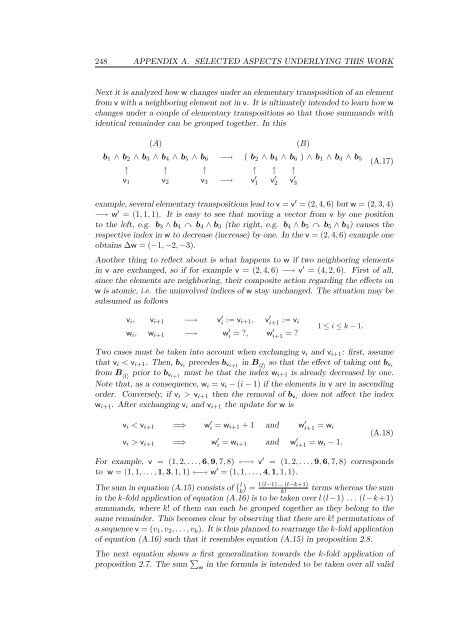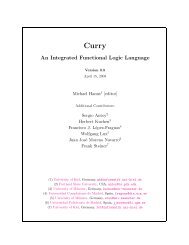Conformal Geometric Algebra in Stochastic Optimization Problems ...
Conformal Geometric Algebra in Stochastic Optimization Problems ...
Conformal Geometric Algebra in Stochastic Optimization Problems ...
You also want an ePaper? Increase the reach of your titles
YUMPU automatically turns print PDFs into web optimized ePapers that Google loves.
248 APPENDIX A. SELECTED ASPECTS UNDERLYING THIS WORK<br />
Next it is analyzed how w changes under an elementary transposition of an element<br />
from v with a neighbor<strong>in</strong>g element not <strong>in</strong> v. It is ultimately <strong>in</strong>tended to learn how w<br />
changes under a couple of elementary transpositions so that those summands with<br />
identical rema<strong>in</strong>der can be grouped together. In this<br />
(A) (B)<br />
b1 ∧ b2 ∧ b3 ∧ b4 ∧ b5 ∧ b6 −→ ( b2 ∧ b4 ∧ b6 ) ∧ b1 ∧ b3 ∧ b5<br />
↑ ↑ ↑ ↑ ↑ ↑<br />
v1 v2 v3 −→ v ′ 1 v ′ 2 v ′ 3<br />
(A.17)<br />
example, several elementary transpositions lead to v = v ′ = (2, 4, 6) but w = (2,3, 4)<br />
−→ w ′ = (1, 1, 1). It is easy to see that mov<strong>in</strong>g a vector from v by one position<br />
to the left, e.g. b3 ∧ b4 � b4 ∧ b3 (the right, e.g. b4 ∧ b5 � b5 ∧ b4) causes the<br />
respective <strong>in</strong>dex <strong>in</strong> w to decrease (<strong>in</strong>crease) by one. In the v = (2, 4, 6) example one<br />
obta<strong>in</strong>s ∆w = (−1, −2, −3).<br />
Another th<strong>in</strong>g to reflect about is what happens to w if two neighbor<strong>in</strong>g elements<br />
<strong>in</strong> v are exchanged, so if for example v = (2, 4, 6) −→ v ′ = (4,2,6). First of all,<br />
s<strong>in</strong>ce the elements are neighbor<strong>in</strong>g, their composite action regard<strong>in</strong>g the effects on<br />
w is atomic, i.e. the un<strong>in</strong>volved <strong>in</strong>dices of w stay unchanged. The situation may be<br />
subsumed as follows<br />
vi, vi+1 −→ v ′ i := vi+1, v ′ i+1 := vi<br />
wi, wi+1 −→ w ′ i = ?, w′ i+1 = ?<br />
1 ≤ i ≤ k − 1.<br />
Two cases must be taken <strong>in</strong>to account when exchang<strong>in</strong>g vi and vi+1: first, assume<br />
that vi < vi+1. Then, bvi precedes bvi+1 <strong>in</strong> B 〈l〉 so that the effect of tak<strong>in</strong>g out bvi<br />
from B 〈l〉 prior to bvi+1 must be that the <strong>in</strong>dex wi+1 is already decreased by one.<br />
Note that, as a consequence, wi = vi − (i − 1) if the elements <strong>in</strong> v are <strong>in</strong> ascend<strong>in</strong>g<br />
order. Conversely, if vi > vi+1 then the removal of bvi does not affect the <strong>in</strong>dex<br />
wi+1. After exchang<strong>in</strong>g vi and vi+1 the update for w is<br />
vi < vi+1 =⇒ w ′ i = wi+1 + 1 and w ′ i+1 = wi<br />
vi > vi+1 =⇒ w ′ i = wi+1 and w ′ i+1 = wi − 1.<br />
(A.18)<br />
For example, v = (1, 2,...,6,9, 7, 8) ←→ v ′ = (1, 2,...,9,6,7,8) corresponds<br />
to w = (1, 1, ...,1,3, 1,1) ←→ w ′ = (1, 1,...,4,1, 1,1).<br />
The sum <strong>in</strong> equation (A.15) consists of � � l l (l−1) ...(l−k+1)<br />
k = k! terms whereas the sum<br />
<strong>in</strong> the k-fold application of equation (A.16) is to be taken over l (l−1) ... (l−k+1)<br />
summands, where k! of them can each be grouped together as they belong to the<br />
same rema<strong>in</strong>der. This becomes clear by observ<strong>in</strong>g that there are k! permutations of<br />
a sequence v = (v1,v2,...,vk). It is thus planned to rearrange the k-fold application<br />
of equation (A.16) such that it resembles equation (A.15) <strong>in</strong> proposition 2.8.<br />
The next equation shows a first generalization towards the k-fold application of<br />
proposition 2.7. The sum �<br />
w <strong>in</strong> the formula is <strong>in</strong>tended to be taken over all valid
















